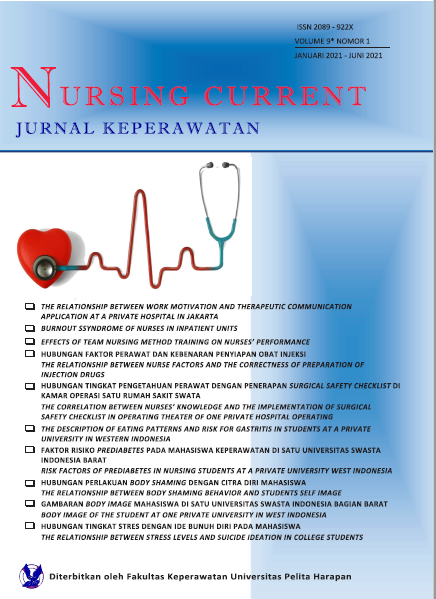BURNOUT SYNDROME OF NURSES IN INPATIENT UNITS
DOI:
https://doi.org/10.19166/nc.v9i1.3452Keywords:
Burnout Syndrome, Inpatient Nurses, Maslach Burnout Inventory-Human Services SurveyAbstract
Burnout is a state of physical, emotional and mental stress caused by chronic workplace pressure. Nurses are often confronted with stress-laden situations related to varied functions and extent of responsibilities causing the burnout syndrome. This study aims to describe the burnout level of inpatient nurses working in the (inpatient) units of a private hospital in West Java. This is a descriptive quantitative study conducted among all the 54 nurses in this hospital’s inpatient units. The Maslach Burnout Inventory-Human Services Survey (MBIHSS), a tool that measures three dimensions of the burnout syndrome: personal accomplishments, emotional exhaustion and depersonalization, was used. Data collected were analysed with the univariate analysis that described the respondents’ characteristics and their responses on the MBI-HSS. Results showed that majority of the respondents are females (94.4%); more than half (61.1%) have a Bachelor of Nursing degree; 74.1% are in the 20-30 years age group; and 51.9% had more than one year of work experience. Moreover, the respondents rated depersonalization characterized by feelings of unreality and strangeness about one's own behaviour as the dimension that highly contributed to burnout (98%). Emotional exhaustion, the feelings of being emotionally overextended and exhausted by one's work was rated low (40.7%). Moreover, personal achievement that measures feelings of competence and successful achievement in one's work had a high 70.4%. The researchers recommend that administrators provide nursing staff with continuing education sessions on strategies to effectively cope with stressful situations in the workplace to counter the burnout syndrome.References
Al-Turki, H. A., Al-Turki, R. A., Al-Dardas, H. A., Al-Gazal, M. R., Al-Maghrabi, G. H., Al-Enizi, N. H., & Ghareeb, B. A. (2010). Burnout syndrome among multinational nurses working in Saudi Arabia. Annals of African Medicine, 9(4), 226-229. https://doi.org/10.4103/1596-3519.70960
Dall’Ora, C., Griffiths, P., Ball, J., Simon, M., & Aiken, L. H. (2015). Association of 12 h shifts and nurses’ job satisfaction, burnout and intention to leave: Findings from a cross-sectional study of 12 European countries. BMJ Open, 5(9). https://doi.org/10.1136/bmjopen-2015-008331
Ersanti, E. R., Ny, V., Bulan, R., Sitanggang, Y. F., Hutasoit, E. O. (2018). Gambaran Kualitas Hidup Profesional Pada Perawat Di Satu Rumah Sakit Swasta Indonesia Bagian Barat Professional Quality of Life of Nurses in Private Hospitals in Western Indonesia. Nursing Current, 6(2), 29-37. http://dx.doi.org/10.19166/nc.v6i2.1906
Guo, Y. F., Luo, Y. H., Lam, L., Cross, W., Plummer, V., & Zhang, J. P. (2018). Burnout and its association with resilience in nurses: A cross-sectional study. Journal of Clinical Nursing, 27, 441-449. https://doi.org/10.1111/jocn.13952
Holdren, P., Paul, D. P., & Coustasse, A. (2015). Burnout syndrome in hospital nurses. BHAA International. https://mds.marshall.edu/mgmt_faculty/141/
Mariyanti, S., & Citrawati, A. (2011). Burnout Pada Perawat Yang Bertugas Di Ruang Rawat Inap Dan Rawat Jalan Rsab Harapan Kita. Jurnal Psikologi, 9(2), 48-59. https://media.neliti.com/media/publications/126201-ID-burnout-padaperawat-yang-bertugas-di-ru.pdf
Maslach, C., & Leiter, M. P. (2016). Understanding the burnout experience: Recent research and its implications for psychiatry. World Psychiatry, 15(2), 103-111. https://doi.org/10.1002/wps.20311
Mudallal, R. H., Othman, W. M., & Al Hassan, N. F. (2017). Nurses’ burnout: The influence of leader empowering behaviors, work conditions, and demographic traits. INQUIRY: The Journal of Health Care Organization, Provision, and Financing, 54, 1-10. https://doi.org/10.1177/0046958017724944
Sari, D. (2015). Hubungan Beban Kerja, Faktor Demografi, Locus of Control Dan Harga Diri Terhadap Burnout Syndrome Pada Perawat Pelaksana Ird RSUP Sanglah. COPING NERS (Community of Publishing in Nursing), 3(2), 51-60. https://ojs.unud.ac.id/index.php/coping/article/view/15724
World Health Organization (WHO). (2019). Burn-out an “occupational phenomenon”: International Classification of Diseases. Retrieved from https://www.who.int/mental_health/evidence/burn-out/en/
Yestiana, Y., Kurniati, T., & Hidayat, A. A. A. (2019). Predictors of burnout in nurses working in inpatient rooms at a public hospital in Indonesia. Pan African Medical Journal, 33(148), 1-8. https://doi.org/10.11604/pamj.2019.33.148.18872
Downloads
Published
How to Cite
Issue
Section
License
Authors who publish with this journal agree to the following terms:
1) Authors retain copyright and grant the journal right of first publication with the work simultaneously licensed under a Creative Commons Attribution License (CC-BY-SA 4.0) that allows others to share the work with an acknowledgement of the work's authorship and initial publication in this journal.
2) Authors are able to enter into separate, additional contractual arrangements for the non-exclusive distribution of the journal's published version of the work (e.g., post it to an institutional repository or publish it in a book), with an acknowledgement of its initial publication in this journal.
3) Authors are permitted and encouraged to post their work online (e.g., in institutional repositories or on their website). The final published PDF should be used and bibliographic details that credit the publication in this journal should be included.

This work is licensed under a Creative Commons Attribution-ShareAlike 4.0 International License.






